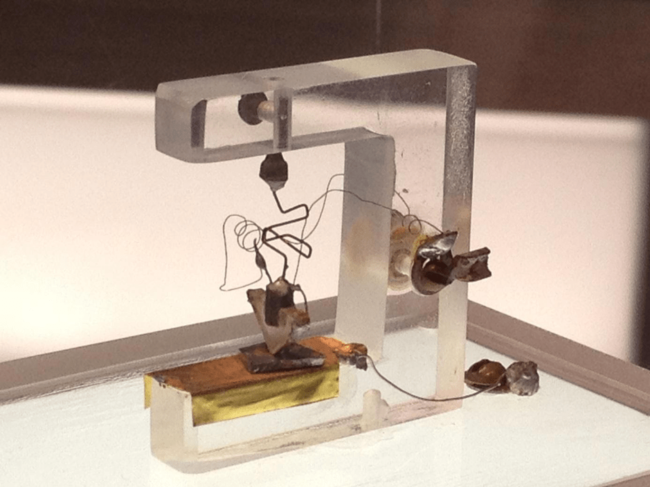Transistor technology
The invention of the transistor in 1947 laid the foundations for technological advancements that developed throughout the remainder of the 20th and early 21st century1. Transistors are composed of a ‘source’ and ‘drain’ terminal, electrical charge flows between these two terminals when a certain external voltage is applied to a third, ‘gate’ terminal. You can modulate the current (rate of flow of electrical charge) between the source and drain by changing the size of the external voltage. This allows transistors to act both as on-off switches and electrical amplifiers2. Transistors are everywhere (and I mean everywhere), from controlling pixels in television screens to making up logic gates (structures that perform calculations and make decisions) in computer processing chips34.
Transistors are great at what they do – until it comes to Moore’s Law. Moore’s Law states that roughly every two years the number of transistors in an integrated circuit doubles5. The problem is that since breaking into the 21st century, the downsizing of transistors has proven more and more difficult. Why?
Because, as transistors are downsized for new devices, changes in electronic properties occur at these smaller dimensions compared to larger materials. Essentially, electrons behave differently in smaller transistors compared to larger transistor devices6. This change in electron behaviour causes electrical currents to go off-track, effectively killing the transistor through “leakage currents”, as electrons flow away from their desired route7.
Advancing electronics with memristors
In order to feed our ever-growing hunger for faster processing and smaller devices, chip makers are turning their attention to an allusive device; the memristor.
Memristors work just like transistors, but instead they only have two terminals: a source and a drain. Memristors don’t require an external gate terminal to control their current, instead allowing current to pass through it depending on the current that previously passed through the device (i.e. the resistance is memory dependent, hence memristor)8.
Memristors are considered superior devices in that they are ‘multi-state’ devices, capable of adopting states beyond the basic binary states that can be adopted by a transistor; on (1) and off (0)9. One memristor can replace many transistors in a computer chip, meaning they are much more powerful and data dense computing units for processing information10.
What’s the catch?
Well, memristors are in the experimental stage1112. They do exist, but not at large scale industrial production levels. However, as transistors become more difficult to downsize, companies will funnel large amounts of time and investment into memristor research13. Memristors are still in their infancy, and indeed they are currently built using complicated fabrication techniques, limiting their industrial applicability14.
Transistors also won’t go down without a fight; scientists are exploring ways to adapt to the smaller dimensions currently limiting transistor downsizing. For example, constraining flowing electrons with carbon nanotubes or single molecules – preventing the electrons from flowing off-track and leaking within the device1516. For the foreseeable future, transistors will dominate our computing technologies, but with inevitable developments of the memristor – their days are surely numbered.
Edited by Frankie Macpherson
References
- https://www.sjsu.edu/faculty/watkins/transist.htm
- https://www.britannica.com/technology/transistor
- https://www.explainthatstuff.com/logicgates.html
- https://www.explainthatstuff.com/howtransistorswork.html
- https://www.intel.com/content/www/us/en/silicon-innovations/moores-law-technology.html
- https://www.technologyreview.com/2020/02/24/905789/were-not-prepared-for-the-end-of-moores-law/
- https://spectrum.ieee.org/semiconductors/devices/the-tunneling-transistor
- https://www.nanowerk.com/memristor.php
- https://spectrum.ieee.org/semiconductors/memory/sixstate-memristor-opens-door-to-weird-computing
- https://www.nanowerk.com/memristor.php
- Nature Nanotechnology, vol 14, January 2019, p 35–39, doi: https://doi-org.ezproxy.lib.gla.ac.uk/10.1038/s41565-018-0302-0
- https://spectrum.ieee.org/semiconductors/processors/how-we-found-the-missing-memristor
- A. Vera-Tasama, M. Gomez-Cano and J. I. Marin-Hurtado, “Memristors: A perspective and impact on the electronics industry,” 2019 Latin American Electron Devices Conference (LAEDC), Armenia, Colombia, 2019, pp. 1-4, doi: 10.1109/LAED.2019.8714735
- https://www.technologyreview.com/2010/04/08/122213/memristor-memory-readied-for-production/
- https://www-03.ibm.com/press/us/en/pressrelease/47767.wss
- https://phys.org/news/2018-06-molecular-insulator-boundaries-current-state.html

